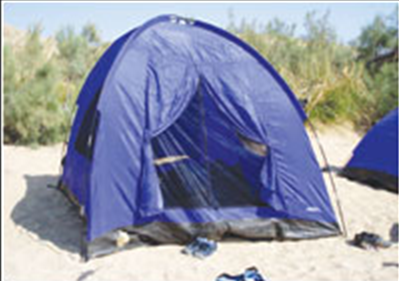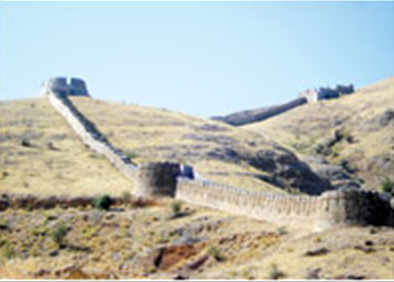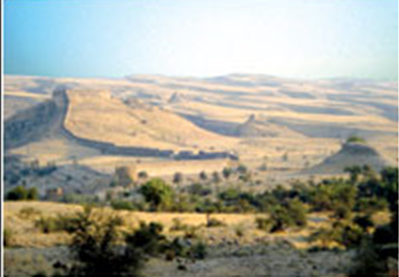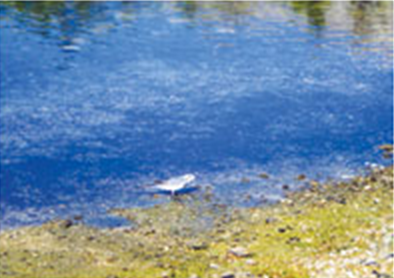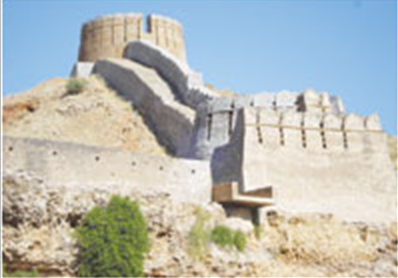Tora Mountains, interior Sindh: Ranikot Fort
This is a collection of articles archived for the excellence of their content. Readers will be able to edit existing articles and post new articles directly |
Tora Mountains, interior Sindh: Ranikot Fort
Exploring the unexplored
By Soonha Abro
Pakistan is a beautiful country, beautiful yet quite unexplored. Everybody knows about places like the Badshahi Mosque in Lahore, Murree, Nathiagali, and Swat. But what about the lesser known places that are as beautiful as these? One does not even think of them, let alone thinking about going there. Come to think of it, only those who are really passionate about the great
outdoors usually go to these places.
My school has set up a club to bring together all the current students of the school who love the great outdoors. The club organises periodic trips to nearby places like the Tora Mountains in Sindh, Mubarak Village and the Thar Desert and therefore, is aptly named the Lyceum Adventure Club (LAC). It aims to bring together all those students of the school who are interested in camping, trekking and hiking, as well as fostering pleasant relationships between the members, teaching how to look after oneself when on a camping-cum-hiking trip as well as looking after the surrounding natural environment. On every trip, there are at least four adults and up to 10-15 students. The concept behind this is that in a group of 10-15 people, everyone interacts with their fellow troop members and thus makes many good friends. This is done to prevent situations where students end up making their own groups.
Being a member of the club, I learnt many things. I learnt how to put up rock tents, cooking on a campfire and doing all those chores we usually do in the safety and comfort of our own homes. Most of all, I learnt to work within a team which was an enriching experience.
The first group, consisting of a total of 16 people, visited the Ranikot Fort in the Tora Mountains in interior Sindh from November 17 - 18, 2007. Ranikot Fort is a huge fort with two smaller forts, namely Shergarh and Mirikot, within its boundary walls. It is so big that if you want to see the whole of it, it will take you up to 15 to 20 days.
We had been told to reach our school by 4:00am. While waiting for departure we spent our time running and screaming around the school like a bunch of rowdy kids, doing /dc= Zsx+evirtually everything we could not have done i[Ier[4wunder normal circumstances. For example, we, the girls, climbed the tree that stood in front of our canteen and took photographs, enjoying ourselves immensely. When it was time to load our luggage in the bus everybody helped to load the bus. That was one of the best things about the trip; there was no discrimination between boys and the girls, everybody could take whatever piece of luggage they could get their hands on.
Joking, laughing, we piled into the bus and the trip began. On the way, we stopped at a restaurant for breakfast. I, very proudly, opened up and handed out the aloo parathas my mother had made for the trip. On the way, most of us made ourselves cosy and fell into a deep sleep, only waking up when we reached our destination. We reached Ranikot around 11:00am after a journey of about six to seven hours and then went to the place where we were supposed to set up the camp. We decided to disembark from the bus and walk and explore the place as we went to our campsite. We enjoyed ourselves immensely, exploring and trying our best to dodge the pesky wasps that were flying around us and not wet our feet in the cold, clear water of the stream we had to cross on our way to the place where the bus was to be parked. We reached our campsite, laden with packs, tents, sleeping bags, foodstuffs and utensils. Together we put up the tents and put away the rest of the things. It was a somewhat difficult job to put up the tents; at least I found it a bit difficult to do so, as I had never done it before. Nevertheless, it was quite a learning experience for me. It felt good to see that we finally managed to put up the tents successfully as most of us were complete novices in this. The heat was scorching. But we had to brave it as we did not have much choice.
Then we had lunch in an area sheltered from the blatant brightness and the boiling heat of the sun, a little distance away from the campsite. At least, it was not as hot as it was at the campsite. After lunch, we had to clear up all the rubbish. This was another important lesson that we learnt, that is not to leave any rubbish around when you eat outside the comforts of your home.
We left around 4:00pm for our trek to Mohankot, an almost five-kilometre-long trek. Here I would like to give the readers a small but an extremely crucial piece of advice: never go hiking without ensuring that you have proper, solid shoes that will support your feet and not tire you out. The reason: I wore old shoes and they fell apart before we even left for the trek. Thus, I ended up trekking in flip-flops which obviously hurt my feet. Anyway, the hike itself was rather fun. We saw fossils of trees that dated back to about a million years. The hike gave us a chance to photograph the rugged beauty of the place. However, the hike also left us with aching bones and scratched bodies, along with memories of an exciting but tiring trek.
We reached our campsite as it got dark, probably around six or seven in the evening. After some rest, it was time to build a campfire and cook dinner. Everybody joined in. Chores were assigned to each of us and everyone got to work on a dinner that I am sure each of us will never forget. After dinner, we went to bed.
The next morning, the whole group left for the trek to Shergarh, which is supposed to be the highest point in the whole of Ranikot Fort. I was unable to go on that trek as I did not have proper shoes and this particular trek was more strenuous than the previous one. Therefore, I stayed back and so did two of my friends along with Ms Shazieh.
Later, we went to a pond that was named ‘Pariyon Ka Talaab’. We had passed it on our Mohankot trek the day before but this time we went down to it for a dip. However, we did not know that there were tiny fishes in the pond that actually nibbled at whatever part of our bodies we immersed in the water. That prevented me from going in for a dip or even putting my feet in the sparkling water, even though I really wanted to do that. We spent some time there till it was time to go back to the campsite and started getting ready for the return journey to Karachi. The ‘talaab’ was another good place for landscape photography and I took as many photographs as I could while taking care not to fall in the pond.
Before leaving Ranikot Fort, we went to visit the Mirikot Fort, another small fort within Ranikot. We walked around the parapet; chatting, cracking jokes and photographing the beautiful landscape of Ranikot and, of course, ourselves. The best part of our visit to the Mirikot was the arrival of a huge gecko that ran into an opening in the wall of the parapet right in front of our eyes and then let us take photographs of it. After visiting Mirikot, we left for Karachi.

